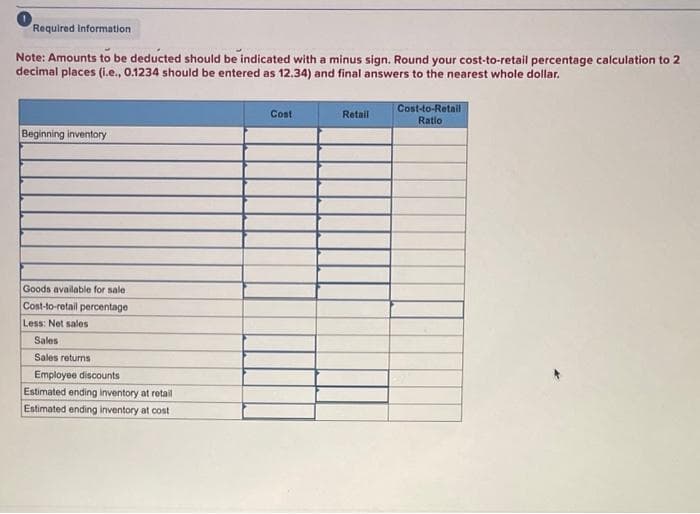Required information (The following information applies to the questions displayed below.) Raleigh Department Store uses the conventional retail method for the year ended December 31, 2022. Available information follows: a. The inventory at January 1, 2022, had a retail value of $41,000 and a cost of $32.170 based on the conventional retail method. b. Transactions during 2022 were as follows: Gross purchases Purchase returns Purchase discounts Sales Salam Cost $ 224,310 6,100 4,600 Retail $450,000 24,000 400,500
Required information (The following information applies to the questions displayed below.) Raleigh Department Store uses the conventional retail method for the year ended December 31, 2022. Available information follows: a. The inventory at January 1, 2022, had a retail value of $41,000 and a cost of $32.170 based on the conventional retail method. b. Transactions during 2022 were as follows: Gross purchases Purchase returns Purchase discounts Sales Salam Cost $ 224,310 6,100 4,600 Retail $450,000 24,000 400,500
Financial Accounting: The Impact on Decision Makers
10th Edition
ISBN:9781305654174
Author:Gary A. Porter, Curtis L. Norton
Publisher:Gary A. Porter, Curtis L. Norton
Chapter5: Inventories And Cost Of Goods Sold
Section: Chapter Questions
Problem 5.2DC
Related questions
Topic Video
Question
Please do not give salutations in image format thankuh
![Required information
[The following information applies to the questions displayed below.]
Raleigh Department Store uses the conventional retail method for the year ended December 31, 2022. Available
information follows:
a. The inventory at January 1, 2022, had a retail value of $41,000 and a cost of $32,170 based on the conventional retail
method.
b. Transactions during 2022 were as follows:
Gross purchases
Purchase returns
Purchase discounts
Sales
Sales returns
Employee discounts
Freight-in
Cost
$ 224,310
6,100
4,600
27,500
Retail
$ 450,000
24,000
400,500
5,000
5,500
Net markups
Net markdowns
Sales to employees are recorded net of discounts.
c. The retail value of the December 31, 2023, Inventory was $59,800, the cost-to-retail percentage for 2023 under the
LIFO retail method was 74%, and the appropriate price index was 104% of the January 1, 2023, price level.
d. The retail value of the December 31, 2024, inventory was $47,080, the cost-to-retail percentage for 2024 under the
LIFO retail method was 73%, and the appropriate price index was 107% of the January 1, 2023, price level.
21,000
24,000
Required:
1. Estimate ending inventory for 2022 using the conventional retail method.
Note: Amounts to be deducted should be indicated with a minus sign. Round your cost-to-retail percentage calculation to 2
decimal places (.e., 0.1234 should be entered as 12.34) and final answers to the nearest whole dollar.](/v2/_next/image?url=https%3A%2F%2Fcontent.bartleby.com%2Fqna-images%2Fquestion%2F567e3a3e-d0fb-49e0-903a-334d72aa92be%2F037e524d-1c62-4418-b93b-6ea9e73054be%2Fwa68sg_processed.jpeg&w=3840&q=75)
Transcribed Image Text:Required information
[The following information applies to the questions displayed below.]
Raleigh Department Store uses the conventional retail method for the year ended December 31, 2022. Available
information follows:
a. The inventory at January 1, 2022, had a retail value of $41,000 and a cost of $32,170 based on the conventional retail
method.
b. Transactions during 2022 were as follows:
Gross purchases
Purchase returns
Purchase discounts
Sales
Sales returns
Employee discounts
Freight-in
Cost
$ 224,310
6,100
4,600
27,500
Retail
$ 450,000
24,000
400,500
5,000
5,500
Net markups
Net markdowns
Sales to employees are recorded net of discounts.
c. The retail value of the December 31, 2023, Inventory was $59,800, the cost-to-retail percentage for 2023 under the
LIFO retail method was 74%, and the appropriate price index was 104% of the January 1, 2023, price level.
d. The retail value of the December 31, 2024, inventory was $47,080, the cost-to-retail percentage for 2024 under the
LIFO retail method was 73%, and the appropriate price index was 107% of the January 1, 2023, price level.
21,000
24,000
Required:
1. Estimate ending inventory for 2022 using the conventional retail method.
Note: Amounts to be deducted should be indicated with a minus sign. Round your cost-to-retail percentage calculation to 2
decimal places (.e., 0.1234 should be entered as 12.34) and final answers to the nearest whole dollar.

Transcribed Image Text:Required information
Note: Amounts to be deducted should be indicated with a minus sign. Round your cost-to-retail percentage calculation to 2
decimal places (i.e., 0.1234 should be entered as 12.34) and final answers to the nearest whole dollar.
Beginning inventory
Goods available for sale.
Cost-to-retail percentage
Less: Net sales
Sales
Sales returns
Employee discounts
Estimated ending inventory at retail
Estimated ending inventory at cost
Cost
Retail
Cost-to-Retail
Ratio
Expert Solution
This question has been solved!
Explore an expertly crafted, step-by-step solution for a thorough understanding of key concepts.
This is a popular solution!
Trending now
This is a popular solution!
Step by step
Solved in 3 steps

Knowledge Booster
Learn more about
Need a deep-dive on the concept behind this application? Look no further. Learn more about this topic, accounting and related others by exploring similar questions and additional content below.Recommended textbooks for you

Financial Accounting: The Impact on Decision Make…
Accounting
ISBN:
9781305654174
Author:
Gary A. Porter, Curtis L. Norton
Publisher:
Cengage Learning

Intermediate Accounting: Reporting And Analysis
Accounting
ISBN:
9781337788281
Author:
James M. Wahlen, Jefferson P. Jones, Donald Pagach
Publisher:
Cengage Learning


Financial Accounting: The Impact on Decision Make…
Accounting
ISBN:
9781305654174
Author:
Gary A. Porter, Curtis L. Norton
Publisher:
Cengage Learning

Intermediate Accounting: Reporting And Analysis
Accounting
ISBN:
9781337788281
Author:
James M. Wahlen, Jefferson P. Jones, Donald Pagach
Publisher:
Cengage Learning


Cornerstones of Financial Accounting
Accounting
ISBN:
9781337690881
Author:
Jay Rich, Jeff Jones
Publisher:
Cengage Learning

Survey of Accounting (Accounting I)
Accounting
ISBN:
9781305961883
Author:
Carl Warren
Publisher:
Cengage Learning

Financial Accounting
Accounting
ISBN:
9781337272124
Author:
Carl Warren, James M. Reeve, Jonathan Duchac
Publisher:
Cengage Learning